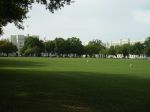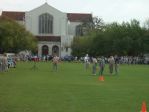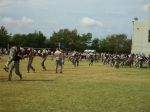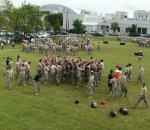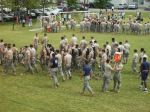A few things I’ve written about conference realignment as it relates to the SoCon over the past few months (listing the most recent first):
Conference realignment, SoCon style: finally, expansion rather than contraction
Conference realignment, SoCon style: history repeats itself
Conference realignment, SoCon style: the football/hoops conundrum
—
This post was inspired by some great work recently done by Shadesof48, a blog focused on William & Mary athletics. Shadesof48 sent in a Freedom of Information Act request to W&M. That request asked for information (primarily emails) from the Tribe’s AD, associate AD, an assistant AD, and the head football coach. The description of the FOI request was as follows:
[M]aterial regarding the school’s future plans about conference affiliation. For example, any correspondences between those people I listed and officials at the Colonial Athletic Association or other conferences as they relate to membership and composition of the Colonial Athletic Association or those other conferences (the Southern Conference, Conference USA, the Atlantic 10 conference, the Big South conference, the Patriot League, or the Sun Belt Conference).
Shadesof48 received copies of 45 emails (with a few attachments) as a result of the request, and published its findings in two posts. The first post delved into emails relating to William & Mary and a possible move to the Patriot League. The second post, released last week, was a look at emails directly tied to CAA realignment discussion.
What I want to do is look at this information in relation to other moves taking place concurrently, and what else had been reported — follow a timeline of events, if you will. By combining information that was already acknowledged with what has been divulged via the CAA emails, a more complete picture of the events of the last two years can be created.
Before reading the rest of my post, I would highly recommend reading both Shadesof48 posts. As I noted earlier, that blog did an excellent job acquiring and then putting together the information, with appropriate analysis to boot. Again, links to those posts: here (William & Mary/Patriot League discussions) and here (general CAA expansion hijinks).
—
In the spring of 2012, things weren’t going so well for the CAA. Georgia State announced in April that it was departing the conference. In May, Virginia Commonwealth and Old Dominion both declared their intent to leave as well.
On the very day ODU announced it was heading to CUSA, CAA commissioner Tom Yeager called his opposite number with the SoCon, John Iamarino, to inform him that the CAA would be talking to multiple SoCon schools about making a switch. However, it appears that Yeager had already been talking to schools in other leagues.
One of those schools was Boston University, then a member of the America East conference and perhaps the CAA’s top choice as an expansion target. On June 15 of that year, however, BU made a surprise shift to the Patriot League, blindsiding Yeager and the CAA.
William & Mary director of athletics Terry Driscoll notified his school president, Taylor Reveley, of the startling news and noted that the league would “continue to explore institutions in the north.” Reveley’s response to BU’s move: “Not helpful.”
Three days later, a clearly concerned Yeager sent an email to Driscoll. For anyone who thought league commissioners don’t pay attention to message board/blog rumors, Yeager’s request for information might come as a surprise:
The blogosphere has the Patriot League recruiting W&M to be the 10th member. Supposedly a W&M Board meeting this week to consider. Any help?
That email was sent on June 18, 2012. Eight days later, Yeager sent another email to the CAA presidents/ADs in which he said:
…I would encourage you not to be too swayed by the latest internet or hallway rumor…We are spending more time calming people down and stomping out erroneous reports than responding to real situations.
Uh-huh. Do as I say, not as I do…
As Shadesof48 reveals, there was truth to the rumors about W&M/Patriot League talks. They had been going on for a while before Yeager’s email, and in fact at least some discussion had apparently taken place off-and-on for at least three years beforehand.
However, William & Mary wouldn’t become the 10th member of the Patriot League. That distinction fell to Loyola (MD), which accepted an invitation in August 2012.
Shadesof48 has a lot more information concerning W&M’s interest in the Patriot League. I’m not going to regurgitate it in this space. I would suggest, however, that Boston University’s jump was a jolt to the Tribe administration in two ways.
Not only did the CAA miss out on a school that would have been acceptable to William & Mary, BU’s move also affected W&M’s own position as a Patriot League candidate. With Loyola later joining Boston University in the fold, the Patriot League no longer had a pressing need for another all-sports member.
—
Now I’m going to move to the meat of the CAA/SoCon information. First, though, I want to point out that Tom Yeager had a very difficult task on his hands.
Yeager has been the only commissioner in the CAA’s entire 28-year history. It’s his league, and he is obviously devoted to it.
With specific regards to adding schools, he has had to deal with some of the same issues as the SoCon’s Iamarino. Those issues include a divide between football and non-football schools, geographic considerations, a public/private balance, and some hard-to-please personalities (we’ll get to Hofstra president Stuart Rabinowitz later).
It’s not an easy job. In general, though, Yeager has been good at navigating through some difficult waters.
I liked his April 2013 report/essay on “General Membership Perspectives”, which includes an excellent breakdown on basketball RPI. Yeager told his league presidents the truth after a tough year in hoops for the CAA:
I believe that we are scheduling properly to position our teams for at-large consideration. In 2012-13 we simply did not win enough, especially key games.
Yeager’s rundown of the basketball profiles of expansion candidates was good. He followed that up with an explanation of scheduling well worth reading, as it is solid, nuts-and-bolts information.
Having said all that, the CAA maneuvering about to be discussed isn’t pretty. It’s easy to second-guess after the fact, to be sure, but some of what the CAA tried to do would have been first-guessed.
—
The week after Yeager’s plea to William & Mary for an update, Adam Smith of the Burlington Times-News tweeted this:
Davidson, College of Charleston and App State – yes, App State – formally have been contacted by the CAA.
Davidson and the CofC weren’t surprises, but Appalachian State was. Smith would write an article the following week explaining why:
Appalachian State, if it were to join the CAA, would be expected to abandon its well-known pursuit of climbing from the Football Championship Subdivision to the top tier Football Bowl Subdivision, because the CAA competes on the FCS level.
That was never going to happen, not unless the CAA became an FBS conference. Why did the CAA think it was possible to land Appalachian State?
From a Yeager email sent to the league presidents on June 26, 2012:
Discussions at the commissioners’ meetings last week further confirms that App State is NOT on the potential expansion list of CUSA…As reported by [UNCW] Chancellor [Gary] Miller, the “dream” may take some time to evaporate, so a decision is not imminent.
The “dream”, in this case, was App’s move to the FBS. The problem with the CAA’s analysis was by that time, the powers that be at Appalachian State were committed to going the FBS route, and had a tagalong partner (Georgia Southern) in case the Sun Belt was the only landing spot.
I understand the basic idea behind approaching Appalachian State along with Davidson and College of Charleston as part of a three-school invite; App would offer geographic relief to Davidson/CofC while also satisfying the CAA’s football contingent (notably James Madison and Delaware). It’s just that by June of 2012, Appalachian State was about as realistic an option as North Carolina State.
Incidentally, in his story Adam Smith also stated that “per multiple sources”, Furman and the CAA had not been in contact with each other. That appears to be borne out by the CAA emails, though other “sources” had told ESPN’s Andy Katz that Furman was “on a lengthy list” (with Elon). That doesn’t mean Katz’s information was completely off base; it may be that the CAA’s prospective list was really, really long.
—
That June 26 email had other items of interest. Of Davidson, Yeager wrote:
As we agreed on the call last Monday [note: I think he is actually referring to the previous Monday, June 18], our plan is to ‘close out Charleston’ which hopefully will create a new dynamic in Davidson’s decision process.
Basically, the CAA decided to bring in CofC in order to force the issue for Davidson. This was not really a new strategy (as I’ve written before, the CAA has tried to put a serious dent in the Southern Conference at least three times since 1996). Ultimately, College of Charleston did join the CAA, the first time a SoCon school had made the direct SoCon-to-CAA switch (the CAA had been rebuffed in previous years by Davidson, Furman, Wofford, The Citadel, VMI, UNC-Greensboro, and yes, CofC).
Yeager also mentioned that “several [school] Presidents were interested in traveling to Charleston to meet with [CofC president George Benson] personally to answer any questions and move the process to conclusion.” This is one of the advantages of being located in Charleston; everyone is more than willing to take a trip to see you, even if an onsite visit isn’t really necessary.
His email on June 26 (it was an info-packed missive) also discussed football-only expansion. Albany and Stony Brook appeared more than ready to accept invites to help create a northern division for the CAA. However, there was a potential glitch.
Patriot League commissioner Carolyn Schlie Femovich had informed Yeager she was “pursuing several CAA schools for football membership”. Those schools were William & Mary, Richmond, Villanova, and New Hampshire. Said Yeager:
I have spoken directly with W&M and Villanova — and indirectly with UR — who all expressed that they are not interested. UNH however, appears very interested in considering the Patriot League…the whole northern expansion plan hangs with UNH.
Obviously, William & Mary had at least some degree of interest, based on the correspondence received by Shadesof48. Actually, a running theme of the emails is that the CAA office never had a very good grasp on what its member schools were considering, or what its expansion candidate schools were mooting as options.
For example, Davidson had evidently been approached by the Atlantic 10 early in 2012, and had been in talks with that league ever since. I’m not sure anyone affiliated with the CAA knew that. If Yeager did in fact know that, it’s not immediately apparent based on subsequent CAA machinations.
One other thing about that June 26 email: in the subject line, Yeager asserted attorney-client privilege. Of course, just asserting the privilege doesn’t mean it automatically applies. I think it’s fair to say that Shadesof48 has conclusively demonstrated it didn’t apply in this case…
—
On August 7, 2012, Albany and Stony Brook accepted football-only invitations from the CAA, becoming serious candidates (if they weren’t already) for full CAA membership as well. Adding the two schools for football had an additional benefit, as Rhode Island reversed course and elected to remain in the CAA for football (as opposed to moving to the NEC in that sport). That was a possibility Yeager had referenced in the June 26 email. In this case, his strategy paid off.
—
After a few delays, the CAA finally got a new all-sports member (not counting football) on November 30, 2012, when College of Charleston joined the league.
A major stumbling point back in October for several board members was the notion of creating a Southern division within the CAA — a conference that now stretches nearly 1,000 miles from Charleston to Boston.
“I would be shocked if the Colonial didn’t come up with a Southern division that all of the people that support the College of Charleston will be pleased with,” said College of Charleston athletic director Joe Hull.
It was the assurance of a Southern division within the CAA from the school’s administration that swayed trustee Jeff Schliz, who voted against the proposal back in October, to back the move on Friday.
“The administration, through its contacts within the Colonial Athletic Association, believes that there are a number of schools changing conferences and coming into the CAA,” Schliz said.
Alas, the CAA was unable to convince Appalachian State or Davidson to join CofC in making the move. As of August 2013, the “number of schools changing conferences and coming into the CAA” for all sports stands at one (Elon).
As I’ve said before, the CAA’s long-sought “expanded southern division” remains as elusive as the Kingdom of Prester John.
—
On January 24, 2013, Georgia Southern AD Tom Kleinlein spoke to a booster club in Savannah. His main purpose at the meeting was to tighten up fan support for GSU’s proposed move to FBS.
Kleinlein told the booster group that the SoCon was considering UNC-Wilmington, Richmond, and Mercer. His intent for stating this was basically to illustrate that the league and GSU were heading in different directions.
I have no idea if Kleinlein’s comments were based on fact. Mercer would eventually join the SoCon, of course, and theoretically Richmond would at least be a feasible football-only candidate. However, I’ve never seen this particular combination of schools mentioned by any other school official, or even from “internet sources”.
The inclusion of UNC-Wilmington was a bit curious because by early 2013, that school had become one of the primary CAA flag-wavers. UNCW owned a special kind of flag, though, one that waved even when there was no wind in the area.
UNCW chancellor Gary Miller became Yeager’s point man among the school presidents. From an email sent by Miller on February 20, 2013:
As the likelihood of the ‘Catholic 7’ from the Big East Conference increases so does the opportunity for the CAA to secure exciting new members. Our previous discussions about membership…demonstrated strong support among our membership for the addition of George Washington University, the University of Richmond and Davidson…I believe it is the feeling of most of us that we would consider reentry for VCU given the right circumstances. Davidson appears to be several years away from a serious consideration of conference realignment. It appears that GW, UR, and VCU will be ‘in play’ to some extent or another in the coming weeks requiring us to give Tom [Yeager] some clear authority to move forward on out behalf. To that end, I am asking you to consider approving the following instructions for [Yeager] in priority order.
I highlighted the part about Davidson being “several years away from serious consideration of conference realignment” because, well, sure. As for Miller’s further comments, he wanted approval for Yeager to approach George Washington with an invite in hand, and also asked if any of the current CAA presidents had a personal relationship with GW’s president. He suggested GW had serious interest in the CAA based on “recent informal discussions” and thought that going after GW first would give the league “better position in reentry discussions” with Richmond and/or Virginia Commonwealth.
Miller also mentioned that Yeager’s information suggested Richmond was “not really in the mix” for a Catholic 7 [now known as the “new” Big East] invite and thus would be “ultimately receptive” to a bid from the CAA.
If Appalachian State getting a CUSA invite was considered a “dream” by Yeager/Miller, what on earth would this proposed George Washington/Richmond/VCU move back to the CAA be? A delusion?
According to Shadesof48, though, at least six CAA members (William & Mary, College of Charleston, Hofstra, Delaware, James Madison, and Northeastern) responded back in support of Miller’s proposal.
Exactly why Miller and/or Yeager thought any of UR/VCU/GW might want to leave the Atlantic 10 to join the CAA is beyond me. The A-10 is the superior hoops league (regardless of recent defections), routinely getting multiple bids to the NCAAs every year, and has a better TV contract. It’s a hoops-centric league for hoops-centric schools.
I can’t imagine how badly the school fan bases (and key boosters) would revolt if Richmond and VCU moved back to the CAA. As for George Washington, maybe its administration had some interest — but on the other hand, GW president Steven Knapp was the chairman of the Atlantic 10 membership expansion committee. I have my doubts the school gave serious consideration to making a switch.
Any hopes the CAA had of pulling off this grandstand play were decisively dashed on March 24, 2013, when George Mason announced it was moving to the Atlantic 10.
—
The next two weeks proved to be trying ones for Yeager. He had to put together another expansion plan, and he didn’t have a lot of time to do it.
Sometime prior to April 4, 2013, the CAA held a conference call among its members; I am not sure if this call included the schools presidents or just the ADs. During the call, the CAA identified five schools as expansion candidates: Albany, Davidson, Elon, UNC-Greensboro, and Stony Brook. Two other schools, Fairfield and Hampton, initiated discussions with the league indicating an interest in joining.
From an April 4 email from Yeager to the league presidents and ADs:
In the past week, direct conversations have occurred with Davidson, Elon, Fairfield and Stony Brook. Albany is next in the line and will be contacted…Most of the individuals involved will be in Atlanta for the Final Four this weekend, and several follow up conversations have been scheduled to occur over the weekend.
…it is our hope to schedule a conference call for the Presidents for Wednesday, April 10 to discuss and authorize the next steps in the process.
…I have also spent a considerable amount of time answering rumors surrounding whether several current CAA members are also exploring other conference options…I am confident that there is no substance to the rumors which are being created and repeated by speculation outside the institution.
…In the last 10 days, our membership strategy has taken a completely different direction. I believe that we are on target, and while changes for the 2013-14 calendar year are preferable, every day that passes makes that goal more problematic.
It looks like Fairfield basically cold calling the CAA worked, as that school immediately jumped into the expansion derby. UNC-Greensboro appears to have been dropped as a serious candidate, with Hampton also not making the cut.
That conference call scheduled for April 10 didn’t happen, though. I’m sure John Iamarino’s next conversation with Tom Yeager will include a discussion of an April 9 email from Yeager to the CAA honchos that included the following:
Over the weekend, several of us had conversations with individuals in Atlanta regarding expansion possibilities. Of particular interest is that the Southern Conference (Davidson & Elon) is conducting a meeting tomorrow which may shed additional light on possible scenarios of interest to the CAA. I would like to postpone tomorrow’s call until later in the week when we have had the opportunity to develop additional information stemming from the SoCon meeting.
It looks like Yeager had someone giving him inside information from the SoCon meeting.
The meeting itself received mixed reviews from the participants, though in retrospect it’s hard to take anything Davidson AD Jim Murphy said about it at face value.
On April 11, Miller of UNCW sent a letter to his fellow CAA presidents:
Tom [Yeager] and/or I have visited with the presidents of Elon, Stony Brook and Davidson…The Presidents of Elon and Davidson have discussed CAA membership with their board executive committees…Based on Tom’s report and analysis…I seek your approval to move forward with membership offers to Davidson, Elon and Stony Brook with the understanding that, as in the past, your final approval will be required for each membership agreement…if further discussion is needed, we will be happy to set up a conference call.
While I cannot guarantee we will succeed in securing all three of these institutions as CAA members, given our preliminary conversations and the dynamics of the Southern and America East Conferences, I believe this is the time to move forward.
In an attachment to the email, Yeager noted that “the best expansion outcome would be to expand to 12 teams” (which would mean adding three schools) and that “14 members could be considered by adding Fairfield and Albany to Davidson, Elon and Stony Brook”.
One school president wasn’t willing to go along with the proposed expansion. No, Hofstra president Stuart Rabinowitz had other ideas, and he expressed them later that same afternoon:
Hofstra University is strongly opposed to the substance and process of the recommendation. As to the process, how would a President vote in favor of extending an offer of membership and later ‘finally’ decide otherwise? At the very least, I believe that collegiality requires that we discuss this dramatic change in our membership via a conference call.
As to substance, the proposal would risk (if Davidson doesn’t accept) substituting two schools which add little to our basketball aspirations to replace George Mason. In addition, as I have said numerous times, adding a school further from [New York City] than Hofstra, but in the same Long Island media and recruitment territory does not make sense to us, especially in light of the fact [that] they are already associated with CAA football.
Rabinowitz has drawn some criticism for these comments following the publication of the emails by Shadesof48. To a certain degree, I can understand his point of view. He was surely correct that the process was rushed and that extending an offer, then making it official only later, was a clumsy way to go about things.
The rest of his comments are really about defending home turf, which is fine as far as it goes. However, Rabinowitz’s decision to torpedo his school’s football program in 2009 is arguably a key reason Hofstra’s status on Long Island (in terms of varsity sports) is in danger of being usurped by Stony Brook in the first place.
His stance only hurt the rest of the league, as Stony Brook would have been a very solid addition for the CAA. It is unclear if the rest of the schools were simply unwilling to cross him, giving Hofstra a de facto “veto” over Stony Brook, or whether two other schools (Northeastern and Drexel being the two most mentioned) joined Hofstra to “block” Stony Brook.
Rabinowitz did get at least one thing right, though, in not assuming Davidson was going to finally join the CAA.
—
After an initial report from CBSSports.com broke the news that Davidson was leaving the SoCon for the Atlantic 10, the school finally confirmed the move on May 8, 2013. The CAA’s long courtship of Davidson had ended, and there would be no marriage between the two.
On April 15, Towson AD Mike Waddell emailed his fellow ADs in the CAA:
If…Davidson is going to the Atlantic 10, then I propose that we…consider Furman for membership for the CAA.
I feel that getting to 12 total schools via adding two southern, and one northern school is imperative for balance in the league and for long term stability. Furman has strong academics, a great overall athletics department, is easy for travel via their airport and they bring the #36 TV market with them as well.
As a group of individually Elon and Furman, along with Albany would be solid additions. We need to act now and be real about the schools that we are considering as well as the institutions [that] may be considering us. We cannot afford to be left at the [altar] any more.
This is the first (and to date only) known reference to Furman made by anyone affiliated with the CAA. While I don’t think Furman would have seriously considered the CAA before (and almost certainly wouldn’t now) barring a complete SoCon implosion, it’s hard to argue with Waddell’s line of reasoning.
The reference to getting to 12 schools was not just a throwaway line, either. Three days later, William & Mary AD Terry Driscoll told his Board of Visitors that “the CAA is hoping to add three schools, to bring the total to twelve.”
Waddell wouldn’t be around for any more CAA expansion talks, though, as he left Towson on May 20.
—
On May 23, Albany announced that it was staying put in the America East for the immediate future. School officials were reportedly concerned with the failure of Stony Brook to get an all-sports CAA invite. Albany’s decision meant that of the top four candidates on the CAA wish list, #1, #2, and #4 were (at least temporarily) off the table. The league finally got some good news that same day, however, when Elon left the SoCon for the CAA.
Elon president Leo Lambert denied a Burlington Times-News report that his school had been opposed to VMI and East Tennessee State joining the Southern Conference, but that denial had been preceded by an unusually strong message by SoCon commissioner Iamarino. To many observers, this suggested there may have been a considerable amount of truth in the newspaper’s assertion; fairly or not, Elon has been slapped with a “does not play nice with others” reputation.
At any rate, Elon was no longer Iamarino’s problem, and vice versa. With Lambert now in the same league with Hofstra’s Rabinowitz, Tom Yeager’s cat-herding skills will be seriously tested. In one of the email attachments, Yeager referred to Elon (and Stony Brook) as “upwardly mobile”.
VMI and ETSU officially got the SoCon nod on May 30, along with Mercer. There is no evidence supporting rumors that the CAA had made a late run at the Macon school.
—
Not part of the CAA emails, but just to briefly mention…
The commissioner of the Patriot League essentially confirmed in May 2013 what had been previously rumored in various corners of the internet, namely that the conference is now focused on football-only members. While Villanova is probably the school most mentioned in this regard, other possibilities may include fellow CAA football schools Richmond, New Hampshire, William & Mary, and Delaware (with the latter two currently all-sports CAA members).
There have also been unconfirmed reports that the Patriot League could have interest in certain SoCon schools as football-only members. To be honest I find that a bit hard to believe.
What strikes me as a more realistic possibility is for the SoCon and Patriot League to form a scheduling alliance of sorts, particularly if the Ivy League schools were to quit playing Patriot League teams that are transitioning to scholarship football. I could see matchups like Furman-Holy Cross (an overload of purple) or Lehigh-The Citadel (the Kevin Higgins Bowl).
—
I’ll wrap this up (phew!) with a few notes:
— Not mentioned at all in any of the CAA correspondence: Coastal Carolina. I found this mildly surprising. It seems CCU didn’t even approach the CAA for potential membership (unlike Hampton and Fairfield).
— Perhaps the key advocate in College of Charleston’s decision to move to the CAA was its president, George Benson, who announced in early August that he would be stepping down as the school’s leader in June of 2014.
— The CAA is presumably still looking to add two members. Albany and Fairfield? Try to convince Hofstra to let Stony Brook into the league for all sports? I’m not sure there is a realistic southern school out there right now (at least, not one with a football program).
— I’m sure everyone is ready for the spring of 2014, and the “will JMU go to FBS?” daily updates. JMU was strictly in observational mode for the entirety of the CAA correspondence uncovered by Shadesof48, perhaps a sign that its administration understands how FOIA works.
— You can bet that schools and conferences around the country will be more careful in the future when discussing sensitive league information via email.
— It is possible that the SoCon is now more stable than the CAA, despite losing five schools — two of them to the CAA.
— While the SoCon is not expected to actively seek to expand, if the right situation is created I fully expect an additional move (or more) to be made. That could happen sooner rather than later.
—
This stuff fascinates me (as you can probably tell). Again, I can’t emphasize enough the excellent job Shadesof48 did.
Now I’m ready for football season. Actually, I’ve been ready for football season…
Filed under: Special Topics | Tagged: AAC, America East, Big South, Boston University, CAA, conference realignment, CUSA, Hofstra, John Iamarino, Loyola (MD), Old Dominion, Patriot League, Shadesof48.com, SoCon, Stony Brook, Sun Belt, Tom Yeager, Virginia Commonwealth, William & Mary | Leave a comment »









